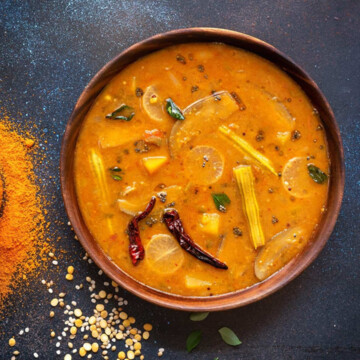
Kerala Sambar Recipe
Kerala Sambar is a tangy South Indian stew made with lentils, vegetables, and spices like tamarind and mustard seeds. Typically served with rice or dosa, it’s a flavorful and nutritious staple of Kerala cuisine.
Ingredients
Ingredients
- ½ Cup Toor Dal (Split Pigeon Peas)
- Tamarind a small lemon-sized ball
- 2 Cup Mixed Vegetables (Drumstick, Carrot, Pumpkin, Okra,etc.) chopped
- 1 Tomato chopped
- 1 Onion sliced
- ½ teaspoon Turmeric Powder
- 2 tablespoon Sambar Powder
- A pinch Asafoetida (Hing)
- Salt To taste
- 2 tablespoon Oil
- 1 teaspoon Mustard Seeds
- 1 teaspoon Cumin Seeds
- 2 Dried Red Chilies
- Curry Leaves a handful
- ¼ Cup Grated Coconut
- 1 tablespoon Coriander Seeds
- ½ teaspoon Fenugreek Seeds
- 2 Dry Red Chilies for Roasting
- Water As required
- Fresh Coriander Leaves For garnish
Instructions
Prepare the Dal
- First, rinse the toor dal in water until the water runs clear.
- Then, cook the dal in a pressure cooker with 2 cups of water and a pinch of turmeric for about 4-5 whistles, until it’s soft. Meanwhile, soak tamarind in ½ cup of warm water, squeeze it to get the juice, and set it aside.
Cook the Vegetables
- Next, heat a tablespoon of oil in a large pan and sauté the onions until they turn translucent.
- After that, add chopped tomatoes and cook until they soften.
- Then, add the mixed vegetables and sauté for a few minutes.
- Now, add 2 cups of water, cover, and cook until the vegetables are tender but not mushy.
Prepare the Spice Paste
- In a separate pan, heat a teaspoon of oil. Roast the grated coconut, coriander seeds, fenugreek seeds, and dry red chilies until they turn golden brown.
- Then, grind this roasted mix with a little water to make a smooth paste. This paste is super important for the rich flavor of Kerala Sambar!
Combine and Simmer
- Now, add the cooked dal to the vegetable mixture. Mix in the tamarind juice, the spice paste, and sambar powder.
- As it simmers, the sambar will thicken, so you can add water if needed to get the right consistency. Don’t forget to season with salt and a pinch of asafoetida, then let it simmer on low heat for about 15 minutes.
Temper the Sambar
- Finally, for the tempering, heat the remaining oil in a small pan.
- Add mustard seeds, cumin seeds, dried red chilies, and curry leaves. When the mustard seeds start to splutter, pour this mix over the simmering sambar and stir well.
- At last, garnish with fresh coriander leaves and turn off the heat. Enjoy your delicious Kerala Sambar!
Notes
Variations
Fusion Fun: Try adding jackfruit or breadfruit for a cool local twist! You can also mix in coconut milk for a creamier, richer texture. Healthy Hacks: Want a lighter version? Simply use less oil or skip the coconut oil for a leaner sambar. Add in more greens like spinach or moringa leaves for extra nutrients and flavor.Tips and Tricks for Perfect Kerala Sambar
First, for the perfect texture, adjust the thickness of your sambar by adding more water if it’s too thick or letting it simmer longer if it’s too watery. You can always tweak it to your liking! Next, to avoid overcooking vegetables, add softer veggies like tomatoes or spinach last. This way, they stay fresh and don’t turn mushy. Then, customize the flavor! Want it spicier? Add more chili. For extra tang, squeeze in some more tamarind. And if you’re vegan, skip any dairy ingredients! Finally, sambar actually tastes better the next day! So, store leftovers in the fridge and reheat on low heat to keep all the flavors intact.Nutrition
Nutrition Facts
Kerala Sambar Recipe
Amount per Serving
Calories
680
% Daily Value*
Fat
20
g
31
%
Saturated Fat
6
g
38
%
Polyunsaturated Fat
3
g
Monounsaturated Fat
8
g
Sodium
600
mg
26
%
Potassium
1800
mg
51
%
Carbohydrates
110
g
37
%
Fiber
20
g
83
%
Sugar
8
g
9
%
Protein
30
g
60
%
Vitamin A
2500
IU
50
%
Vitamin B1
0.4
mg
27
%
Vitamin B2
0.3
mg
18
%
Vitamin B3
4
mg
20
%
Vitamin B5
0.6
mg
6
%
Vitamin B6
0.5
mg
25
%
Vitamin C
35
mg
42
%
Vitamin E
2
mg
13
%
Vitamin K
10
µg
10
%
Calcium
150
mg
15
%
Iron
6
mg
33
%
* Percent Daily Values are based on a 2000 calorie diet.
Tried this recipe?Let us know how it was!